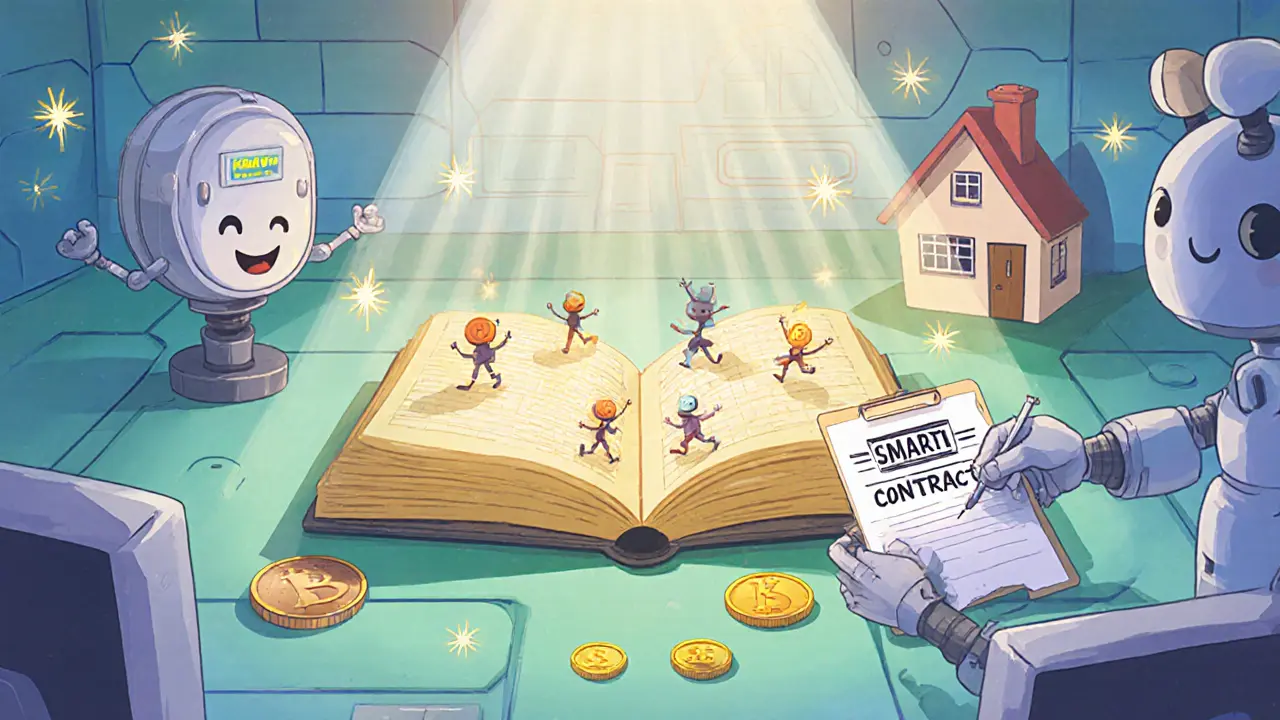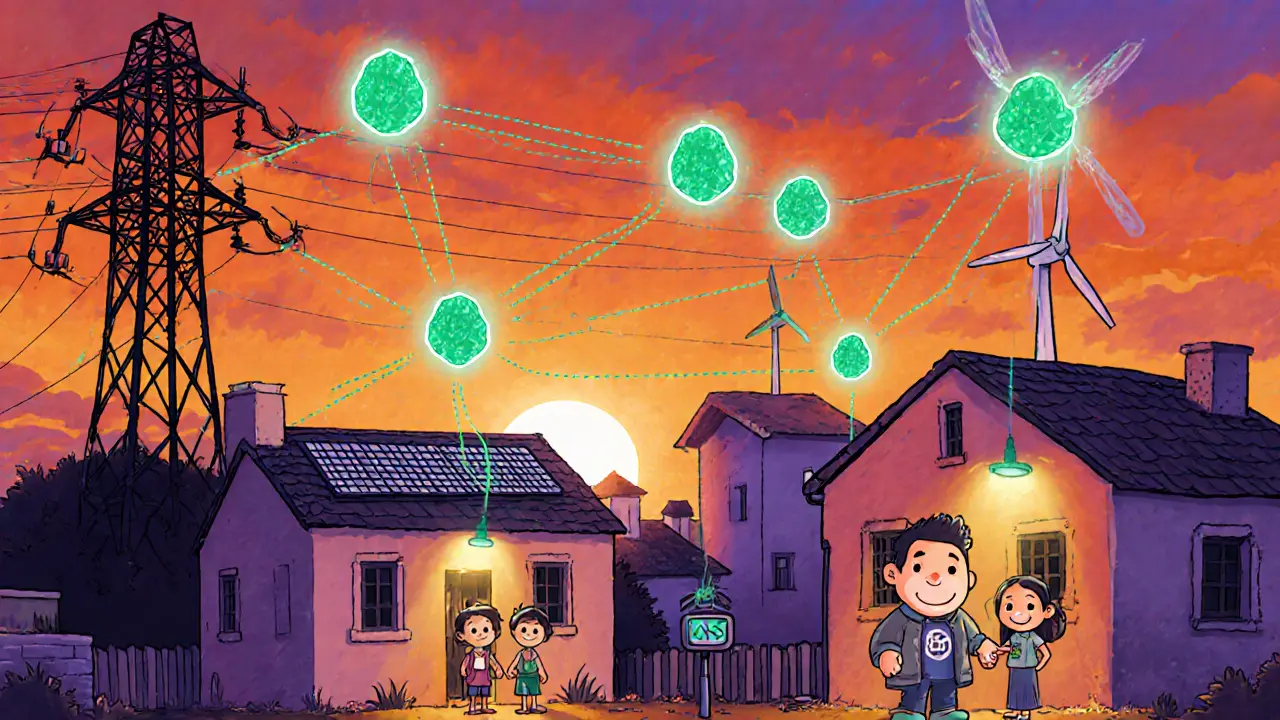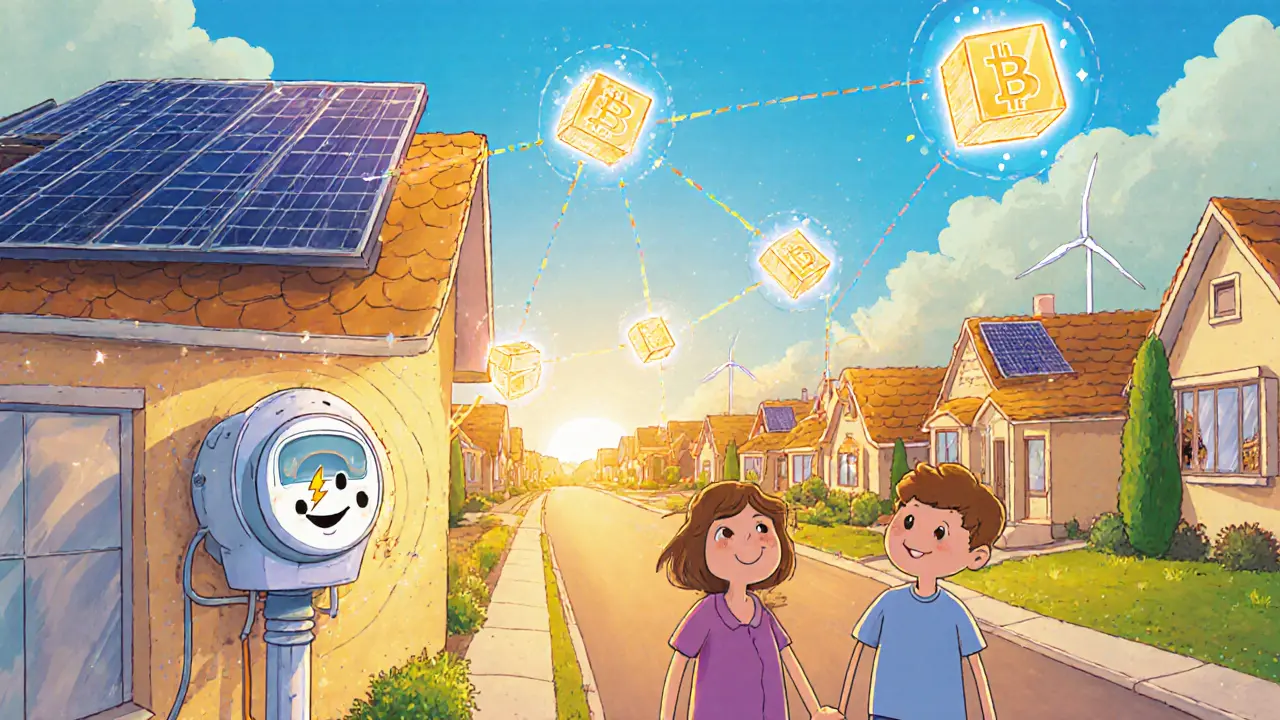Blockchain Energy Trading is a decentralized, peer-to-peer system that uses distributed ledger technology to match renewable energy supply and demand, cutting out middlemen and automating every step with code. Want to know why this matters? Below are the core advantages you’ll feel in your wallet, on the planet, and in everyday power use.
- Lower costs by removing brokers and automating settlements.
- Transparent, tamper‑proof records that boost trust.
- Real‑time balancing of supply and demand via smart contracts.
- New revenue streams for households with solar panels.
- Stronger, more resilient local grids.
1. Cost Efficiency Through Automation
Every traditional energy transaction hops through several layers - generators, distributors, market operators, and finally retailers. Each hand adds fees, paperwork, and latency. With Smart Contracts embedded on a blockchain, the moment a prosumer’s meter reports excess kilowatts, the contract automatically matches a buyer, records the trade, and triggers payment without a human signing a line.
Studies from pilot projects in Germany and Australia show up to a 15% - 20% reduction in transaction costs compared with legacy systems. For a typical suburban household that produces 5kWh extra per day, those savings translate into roughly $30‑$40 per year - a non‑trivial amount when multiplied across a neighborhood.
2. Transparency and Security You Can Verify
Because each trade is written into an immutable block, anyone with access to the ledger can audit the history. No one can retroactively change the amount of energy sold, the price, or the timestamp without breaking the cryptographic hash chain.
Peer-to-Peer Energy Marketplace platforms display these records on a simple dashboard, letting participants see exactly how much they bought or sold and at which price. This transparency builds confidence, especially for newcomers who have never dealt directly with strangers over electricity.
3. Decentralized Control and Programmable Grids
Traditional grids are managed by a few large utilities that decide where power flows. In a blockchain‑driven system, control is distributed across all nodes. Decentralized Grid architecture means that each participant can set preferences - for example, “only buy solar power when price < $0.10/kWh”. The network enforces these rules automatically.
This programmability opens the door to dynamic pricing, automated load shedding during peak periods, and even market‑based incentives for energy‑saving behaviors.
4. Real‑Time Supply‑Demand Matching
Renewable generation is inherently variable - clouds pass, wind gusts cease. Blockchain platforms continuously broadcast available capacity. When supply exceeds local demand, the system instantly finds nearby consumers willing to pay the current price. Conversely, when demand spikes, the ledger matches the highest‑bidding buyers with the nearest sellers.
The result is a tighter balance, less wasted solar energy, and fewer instances of “curtailment” where excess power is simply dumped.
5. New Revenue for Homeowners and Small Producers
Households with rooftop solar or micro‑wind turbines become Energy Prosumers - both producers and consumers. Instead of waiting for a utility’s wholesale rate, they set their own price, often higher than the utility’s feed‑in tariff but lower than commercial rates.
In a pilot in New Zealand’s Bay of Plenty, participants earned an average of 12% more revenue from excess power than they would have received through the national feed‑in scheme. Those extra earnings help offset installation costs, making renewable upgrades more attractive.

6. Grid Resilience and Stability
When power flows through a single, centralized hub, a fault can cascade into a blackout. A blockchain‑enabled network spreads risk across many nodes. If one node goes offline, the ledger instantly reroutes power through alternative peers, maintaining service.
During the 2024 heatwave in Southern Spain, a blockchain‑based micro‑grid kept 85% of its connected homes powered even after the main transmission line failed, showcasing the technology’s ability to act as a built‑in backup.
7. Environmental Sustainability Benefits
By making renewable energy easier to trade, blockchain accelerates the shift away from fossil fuels. Faster, transparent transactions mean that surplus wind or solar can be absorbed locally instead of being wasted. The net effect is a measurable reduction in carbon emissions - one study estimated a 3‑5% drop in CO₂ intensity for regions that adopted peer‑to‑peer trading for just one year.
8. Data Privacy and Ownership
Energy usage data is highly personal. Traditional utilities store this information in centralized databases vulnerable to breaches. Data Privacy on a blockchain is achieved through cryptographic encryption and selective disclosure. Users can prove they paid for energy without revealing exact consumption patterns.
This reduces the risk of price‑gouging or profiling by monopolistic providers and aligns with emerging data‑protection regulations worldwide.
Comparison: Traditional vs. Blockchain Energy Trading
| Aspect | Traditional Model | Blockchain Energy Trading |
|---|---|---|
| Intermediaries | Multiple (generators, distributors, retailers) | None - peer‑to‑peer via smart contracts |
| Transaction Cost | 5‑15% of trade value | 0‑2% (network fee only) |
| Transparency | Limited, proprietary records | Full, immutable ledger visible to all participants |
| Speed of Settlement | Hours to days | Seconds to minutes |
| Market Access | High barriers for small producers | Open to any prosumer with a meter |
| Grid Resilience | Centralized, single‑point failures | Distributed, automatic rerouting |
| Data Control | Utility‑owned databases | User‑owned encrypted keys |
Getting Started: Simple Steps for Homeowners
- Install a smart meter that can communicate with a blockchain platform.
- Register on a reputable Peer-to-Peer Energy Marketplace (e.g., PowerChain, EnergiaX).
- Connect your solar inverter or wind turbine to the platform’s API.
- Set your preferred pricing rules - fixed price, time‑of‑use, or dynamic.
- Monitor trades in real time via the mobile dashboard; earnings are auto‑deposited into your linked bank account.
Most platforms charge a nominal network fee (usually <0.5% of the transaction) and provide free onboarding guides.

Frequently Asked Questions
Can I sell energy if I don’t have solar panels?
No. The current model requires you to generate excess power first. However, many communities allow members to buy a share of a local solar farm and receive credit through the same blockchain platform.
Is the blockchain energy data private?
Yes. Transactions are encrypted, and participants can choose what data to reveal. Only the hash of the transaction is public, not the specific kWh amount unless you opt‑in.
What happens during a power outage?
If the local grid fails, the blockchain network can automatically re‑balance supply among remaining active nodes, delivering backup power from nearby prosumers who still have generation capacity.
Do I need crypto to use these platforms?
Most platforms settle in fiat (USD, NZD, EUR) and handle the crypto conversion behind the scenes, so you don’t need to manage wallets directly.
Is blockchain energy trading regulated?
Regulation varies by country. In NewZealand, the Electricity Authority is drafting guidelines for P2P trading, and platforms must meet data‑privacy and grid‑safety standards.
Blockchain energy trading isn’t a magic wand, but the benefits stack up fast: cheaper bills, cleaner power, and a sturdier grid that belongs to the people who use it.


Comments
Katrinka Scribner
I can't even 😭 think about how much money we could save when the middlemen disappear! This blockchain thing feels like a super‑charged community garden for energy 🌱. Sure, the tech sounds complex, but the vibe is totally hopeful 😍. Imagine your neighbour paying you for that extra solar juice you generate – it's like a friendly piggy‑bank that never runs out. Yeah, there might be glitches, but the excitement is real! 🌟
October 27, 2024 AT 20:05
VICKIE MALBRUE
This is a game changer for all of us
October 28, 2024 AT 09:59
Waynne Kilian
Reading through the benefits feels like taking a stroll through a garden of possibilities; each bloom represents a new way to empower our neighborhoods. I reckon the transparency offered by an immutable ledger could foster trust among folks who'd otherwise be wary of trading power with strangers. Sure, the tech might sound like sci‑fi, but at its heart it's just people sharing sunlight and wind. If we let philosophy guide us, we might see energy as a communal good rather than a commodity. And even with a few typos here and there, the core idea shines bright.
October 28, 2024 AT 23:52
Naomi Snelling
Look, nobody's gonna tell you why the big utilities are so eager to push this blockchain hype. They're probably brewing some secret algorithm to keep the real control in their hands while pretending we're getting freedom. I don't trust a system that records everything if the same companies still own the hardware. Keep your eyes open, the power structures rarely vanish just because we add code.
October 29, 2024 AT 13:45
Michael Wilkinson
Cut the fluff, the numbers speak for themselves.
October 30, 2024 AT 03:39
Billy Krzemien
Great overview! The way you broke down each advantage makes it easy for anyone to grasp the real impact. I especially appreciate the note on cultural inclusion-blockchain can bridge gaps between urban and rural communities, giving each a voice in the energy market. Keep sharing this knowledge; it’s essential for driving adoption worldwide.
October 30, 2024 AT 17:32
april harper
Energy trading on a blockchain feels like a modern parable: we seek freedom, yet we build new chains of code. The concept dazzles, but the day‑to‑day relevance remains a quiet whisper.
October 31, 2024 AT 07:25
Clint Barnett
When you peel back the layers of blockchain‑enabled energy markets, what emerges is a tapestry woven from technology, economics, and human behavior. First, the removal of intermediaries slashes transaction fees, allowing households to keep more of the revenue generated by their rooftop panels. Second, the immutable ledger guarantees that every kilowatt‑hour is accounted for, eradicating disputes that once plagued traditional utilities. Third, smart contracts automate settlement in seconds, which translates into cash flowing to prosumers almost as soon as the sun sets. Fourth, the system's transparency invites new participants, from community co‑ops to small businesses, fostering competition that drives innovation. Fifth, the decentralized architecture enhances grid resilience; if one node falters, the network reroutes power seamlessly. Sixth, real‑time pricing signals encourage consumers to shift usage to off‑peak hours, flattening demand curves and reducing the need for costly peaker plants. Seventh, the data privacy mechanisms embedded in cryptographic protocols protect users from intrusive profiling while still proving compliance. Eighth, the environmental upside is palpable-by capturing excess renewable output locally, we cut greenhouse emissions measurably. Ninth, the model empowers energy justice, granting low‑income neighborhoods access to affordable clean power. Tenth, local micro‑grids can act as islanded backups during large‑scale outages, as demonstrated in Spain's 2024 heatwave. Eleventh, the global scalability of blockchain means that lessons learned in one region can be replicated elsewhere with minimal friction. Twelfth, developers can layer additional services-like demand‑response incentives-directly onto the same ledger. Thirteenth, the open‑source nature invites community scrutiny, accelerating security hardening. Fourteenth, policymakers gain a transparent audit trail, simplifying regulation and compliance. Fifteenth, consumers enjoy a user‑friendly dashboard that demystifies energy flow, making the abstract tangible. Finally, the cultural shift toward peer‑to‑peer collaboration nurtures a sense of ownership that transcends mere consumption, turning every household into an active player in the energy ecosystem.
October 31, 2024 AT 21:19
Jacob Anderson
Oh great, another buzzword paper promising to solve everything with blockchain. Because that’s worked out so well in every other industry.
November 1, 2024 AT 11:12
Kate Nicholls
While the enthusiasm is commendable, the article glosses over the regulatory hurdles that could stall implementation for years. A balanced view would also address the energy overhead of proof‑of‑work systems, even if many projects are moving to proof‑of‑stake.
November 2, 2024 AT 01:05
Carl Robertson
Honestly, the drama of a decentralized grid sounds like a sci‑fi thriller, but the real world is messy-price volatility, technical glitches, and the inevitable turf wars between incumbent utilities and startups. Still, the narrative is compelling, even if I prefer to stay on the sidelines.
November 2, 2024 AT 14:59
Rajini N
If you're considering joining a peer‑to‑peer platform, start by ensuring your smart meter complies with the API standards of your chosen marketplace. Next, review the fee structure; most networks charge only a small nominal fee for transaction validation. Finally, monitor the settlement times-most platforms settle within minutes, not days, which can improve cash flow for small producers. Following these steps will help you get the most out of the system.
November 3, 2024 AT 04:52
Sidharth Praveen
Keep the momentum going! Every new prosumer adds strength to the community, and the collective impact will be massive.
November 3, 2024 AT 18:45
Sophie Sturdevant
From a technical standpoint, the integration of distributed ledger technology with IoT-enabled smart inverters creates a synergistic stack that leverages cryptographic hash functions for tamper‑proof energy accounting, thereby reducing operational expenditures and enhancing grid elasticity.
November 4, 2024 AT 08:39
Nathan Blades
Imagine a world where your rooftop panels not only power your home but also negotiate contracts with neighbors in real time, like a bustling marketplace of electrons. The excitement is palpable, and the possibilities are endless-dynamic pricing, automated load balancing, and a true democratization of energy. Let’s ride this wave together!
November 4, 2024 AT 22:32
Somesh Nikam
Love the optimism here 😊! It’s great to see such clear steps for homeowners, and the community vibe really shines through. Keep the info coming, and let’s all empower each other.
November 5, 2024 AT 12:25
Jan B.
Solid summary, concise and on point.
November 6, 2024 AT 02:19